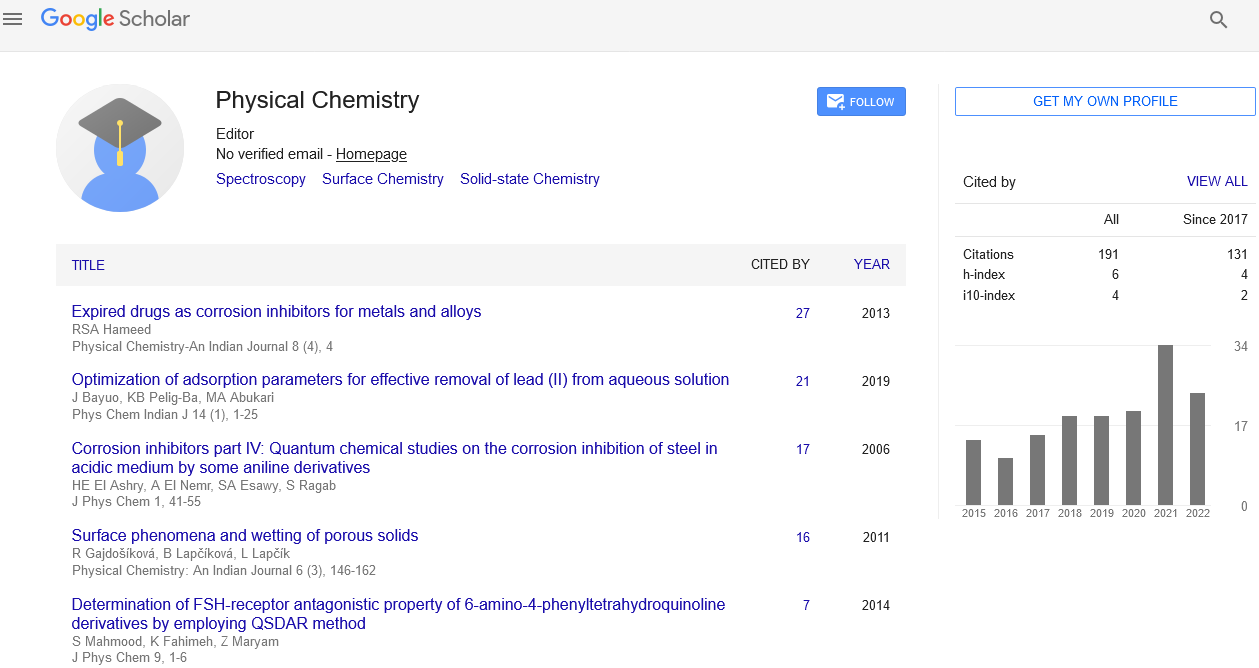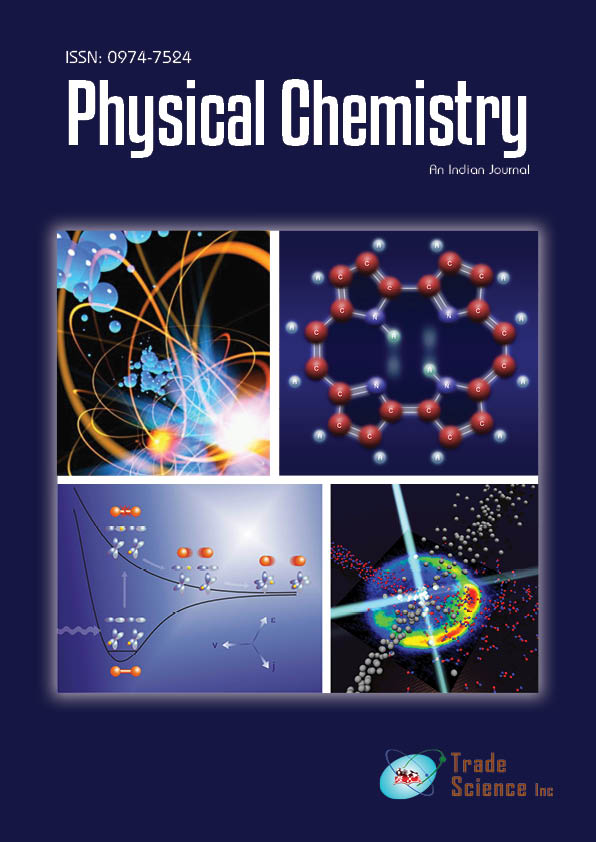Review
, Volume: 17( 4)A Review of Dissolved Gas Analysis in Power Transformers
- *Correspondence:
- Carolina Levresse
Editorial Office, Physical Chemistry: An Indian Journal, West End Southampton Hampshire, UK
E-mail: zxzdcoyk@yahoo.com
Received date: July 17, 2022, Manuscript No. M- tspc-22-79600; Editor assigned: July, 19, 2022, PreQC No. P- tspc-22-79600;; Reviewed: August 7, 2022, QC No. tspc-22-79600; Revised: August 12, 2022, Manuscript No. R- tspc-22-79600 (R); Published: August 25, 2022, DOI: 10.37532/2320–6756.2022.17(4)
Citation: Carolina Levresse. A Review of Dissolved Gas Analysis in Power Transformers. Phys. Chem.: Indian J.2022;17(4):262.
Abstract
Transformers' Dissolved Gas Analysis (DGA) can shed light on the thermal and electrical stressors they endure. transformers that are submerged in oil. DGA is able to identify transformer failures before they become more serious. damage. Additionally, DGA is a sensitive and trustworthy method for identifying impending fault conditions in oil-immersed transformers. The several techniques created for examining these gases and determining their importance include Key Gas, the Dornenburg, Rogers, Nomograph, IEC, Duval, and CIGRE ratios. This research contrasts how well various techniques work at reading transformer conditions.
Keywords
Rogers Ratio Method; Nomograph Method; IEC Ratio Method; Duval Triangle Method
Introduction
Major components of the power system include large power transformers. Their dependability has an impact on a utility's capacity to operate profitably as well as the availability of electric energy in the area they provide.
Power transformer failures are problematic for four reasons: the system may experience operational issues as a result of the failure; large power transformers are typically housed in sizable tanks filled with flammable oil and pose an environmental risk; the utilities lack a backup transformer in the event of maintenance; and finally, the various types of thermal and electric stresses frequently cause the transformers to age prematurely and expose them to developing faults. As a result, the utilities must monitor the transformer's condition and create a diagnosis system.
A mixture of solid impregnated cellulose and liquid transformer oil is utilised as the insulating oil in power transformers. Ageing and deteriorating insulation are the two main sources of developing defects.
Thermal stresses, electrical strains, mechanical stresses, and moisture are the main factors that cause insulation to age and deteriorate. DGA methods can assess the ageing process, the degrading cellulose content of the transformer oil, measures of the degree of polymerization, and Furan analysis.
The detection of certain gases generated and dissolved in power transformers in service is often the first available indication of a malfunction that, if uncorrected, can eventually cause a transformer failure. The gases generated in oil-filled transformers can be used for qualitatively determining fault types since the gases are typical or predominant at various temperatures. After incipient faults are detected, preventive maintenance can be performed, and conditions can be assessed by DGA. This study reviewed the various conventional and non-conventional DGA methods used by various agencies and utilities to monitor the condition of the cellulose contained in in-service transformers.
DGA Approaches
The DGA is among the most common techniques used for on-line incipient fault diagnosis because the transformer need not be deenergized. The DGA requires routine oil sampling and modern technologies for on-line gas monitoring. The key step in using gas analysis for fault detecting is correctly diagnosing the fault that generated the gases [1,2]. Abnormal electrical or thermal stresses cause insulation oil to break down and to release small quantities of gases. The composition of these gases depends on the fault type. The detection of certain level of gases generated in oil-filled transformer in service is often the first available indication of a malfunction that can cause a transformer failure if not corrected. Possible mechanisms of gas generation include arcing, corona discharge, low energy sparking, overheating of insulation due to severe overloading, and failure of forced cooling systems. Faults in oil-filled transformers can be identified according to the gases generated and the gases that are typical or predominant at various temperatures. These gases are hydrogen (H2), methane (CH4), ethylene (C2H4), ethane (C2H6), acetylene (C2H2), carbon monoxide (CO), and carbon dioxide (CO2). Each fault type produces gases that are generally combustible. An increase in Total Combustible Gases (TCG) that correlates with an increase in gas generating rates may indicate the existence of any one or a combination of thermal, electrical or corona faults.
This study investigated and compared seven current methods of using dissolved gas data to diagnosis fault type:
• Rogers Ratio Method
• Nomograph Method
• IEC Ratio Method
• Duval Triangle Method
Rogers Ratio Method
The Rogers ratio method [3], which distinguishes more thermal fault types than the Dornenberg ratio method [4], is the most popular gas ratio method. Four gas ratios are examined by the Rogers method: CH4/H2, C2H6/CH4, C2H4/C2H6, and C2H2/C2H4. A straightforward coding system based on the ratios' ranges is used to identify faults. The Rogers ratio is a straightforward method for identifying defects that is based on ratio ranges. An oil-insulated transformer can be detected in four different states: normal ageing, partial discharge with or without tracking, electrical and thermal failures of varied severity, and normal ageing. The IEEE Standard C57.104-2008 [1] also includes this technique, which is based on the concepts of thermal deterioration. This method is effective because it correlates the results of numerous failure investigations with the gas analysis of each case. However, some ratio values are inconsistent with the diagnostic codes assigned to various faults in this method. Also, since the method does not consider dissolved gases below normal concentration values, a precise implementation of the method may still misinterpret data.
Nomograph Method
By merging the notion of Key Gas threshold with fault gas ratios, the Nomograph Method [5] increases the accuracy of fault identification. It makes it easier to analyse fault gas data by showing it graphically. The concentration of various gases is shown on a nomograph as a series of vertical logarithmic scales with parallel lines drawn between them. The points that reflect the values of the various gas concentrations are connected by the lines. The sort of issue can be diagnosed using straight lines. By visually comparing the slopes of line segments with the keys at the bottom of the nomograph, fault types are determined. The placement of lines connected to the concentration scales reveals the severity of the fault. Each vertical scale's threshold value is denoted by an arrow. For the slope of a line to be considered significant, at least one of the two tie points should exceed the threshold value. The fault is not considered significant if the tie point lies above a threshold value.
IEC Ratio Method
The C2H6/CH4 ratio, which only indicates a specific temperature range of decomposition, is not included in the IEC Ratio Method [5], which is similar to the Rogers Ratio Method. In contrast to the Rogers ratio method, the following three gas ratios have different ranges of coding. The Rogers approach served as the basis for the fault diagnosis methodology advised by the International Electrotechnical Commission (IEC), with the exception that the C2H6/CH4 ratio was disregarded because it only indicated a narrow temperature range of decomposition. Normal ageing, partial discharges with low and high energy densities, thermal faults, and electrical faults with varied degrees of severity are the four situations that were found. However, it does not distinguish between specific subtypes of thermal and electrical defects. The IEC method's initial iteration (IEC 60599-1978) is based on the second edition (IEC 60599-1999) employs directly altered ratio ranges while the first uses a straightforward coding method. Before interpreting dissolved gases using ratios, dissolved gases must be evaluated for "normality" limitations. Another The 3D graphical representation of ratio ranges is an advance in the second iteration of the IEC approach. Undiagnosed faults are put into the graph so that their proximity to a specific fault can be determined. then the area can be seen. Partial discharges are a common classification for power transformer failures,discharges with varying energies, thermal faults whose severity changes with fault temperature
Duval Triangle Method
The only three gases used in the Duval Triangle Method [6-7] are CH4, C2H4, and C2H2, and their locations on a triangle map. Gases are converted into triangular co-ordinates and used to plot the triangle. Partial discharges, electrical faults (high and low energy arcing), and thermal faults are the three forms of visible defects (hot spots of various temperature ranges). Even though this method is simple to use, incorrect diagnosis might result from improper application because no part of the triangle is identified as an example of normal ageing. Therefore, the allowable amount of dissolved gases should be established before employing this method to examine transformers that have been in service for a long time [8,9].
Conclusion
Identifying the defect that caused the gases to be identified and detected is the main goal of fault gas analysis.
The seven most popular techniques for assessing dissolved gas data to determine fault type were examined and compared in this study: Key Gas, Dornenburg Ratio, Rogers Ratio, Nomograph, IEC Ratio, Duval Triangle, and CIGRE. This study provides a helpful overview of DGA applications in power transformer fault diagnosis by contrasting the consistency and accuracy of each method in predicting faults. Researchers and field engineers can diagnose transformer faults using the study's conclusions.
When analyzing using all the methods we observed that transformer failures using the generating rate approach and other industry standards, multiple or conflicting fault interpretations may be found. Optimizing the use of multiple diagnostic procedures is thus a crucial topic. Additionally, specialists frequently adopt the aforementioned DGA diagnosis approaches as a general guideline because they are computationally straightforward, efficient, and capable of identifying serious errors. The complexity of gas generating processes in oil, gas sampling techniques, and laboratory chromatographic analysis, although, causes a great deal of ambiguity in gas data. Due to the variable intensities of energy wasted by various faults—which are influenced by a variety of elements, including oil type, oil temperature, sampling method, insulation qualities, and environmental effects—various patterns and quantities of gases are produced.
Furthermore, the majority of DGA diagnosis methods rely on expert evaluations, which may be blind to small, slowly growing flaws. Even under normal circumstances, unforeseen procedures like welding on oil tanks and the electric charge carried by the oil flow might lead to errors in judgement. Many researchers have tried a variety of ways to tackle the uncertainties in defect detection, which is based on the gas contents retrieved from transformer oil samples, including expert systems, fuzzy logic inference, and artificial neural networks. First, fault categories are categorised based on on-site experience using a combination of the key gas technique, total combustible gas method, gas generation rates, and on-site inspections. Various artificial intelligence methods are then used to reveal the relationships between fault symptoms and malfunction types founded on gas-fault mapping schemes. The choice of diagnosis techniques is made more difficult by the fact that several transformer test procedures, including as DGA, thermal analysis, frequency response analysis, and partial discharge analysis, each have their own advantages and disadvantages. Therefore, pooling the results from all significant test procedures and including their data in an overall review is a more logical strategy. An appropriate information integration approach is required to process DGA data in order to take into consideration the potential for test results to be unclear and even incomplete

